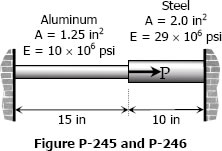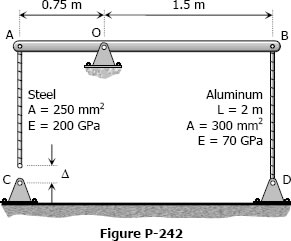Solution to Problem 247 Statically Indeterminate
Problem 247
The composite bar in Fig. P-247 is stress-free before the axial loads P1 and P2 are applied. Assuming that the walls are rigid, calculate the stress in each material if P1 = 150 kN and P2 = 90 kN.





 As shown in Fig. P-241, three steel wires, each 0.05 in.2 in area, are used to lift a load W = 1500 lb. Their unstressed lengths are 74.98 ft, 74.99 ft, and 75.00 ft.
As shown in Fig. P-241, three steel wires, each 0.05 in.2 in area, are used to lift a load W = 1500 lb. Their unstressed lengths are 74.98 ft, 74.99 ft, and 75.00 ft.
